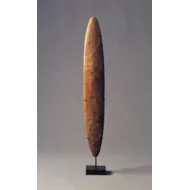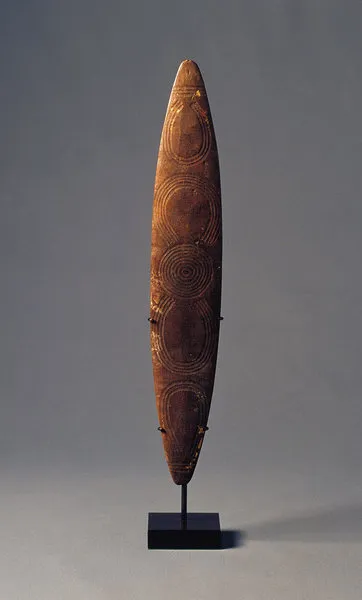Two North Australian Aboriginal Tjuringa or Sacred Boards , Wardaman Tribe . Wood and earth pigments
Two North Australian Aboriginal Tjuringa or Sacred Boards , Wardaman Tribe . Wood and earth pigments
19 th – 20 th Century
Size : A 46 cm long , 7 cm wide – 18 ins long , 2¾ ins wide
B 39 cm long , 6.5 cm wide – 15¼ ins long , 2½ ins wide
19 th – 20 th Century
Size : A 46 cm long , 7 cm wide – 18 ins long , 2¾ ins wide
B 39 cm long , 6.5 cm wide – 15¼ ins long , 2½ ins wide
Tjuringa are the most sacred forms of aboriginal art . They embody the totemic spirits of it's owner , his ancestors and of the creator spirits . They were displayed at iniations by elders to explain traditions and legends to novices and kept carefully wrapped in bark in special store houses when not in use .
The linear incisions on their surfaces most probably refer to myths , maps of the heavens and the landscape , plants , animals and their tracks , but without direct information from it's original owner it is impossible to accurately interpret .
To quote Frederick McCarthy ( Australian Aboriginal Decorative Art 1958 page ; 29 )
'concentric circles usually represent the principle feature of the myth portrayed such as the spiritual ancestor , places where he camped , went into or came out of the ground , distributed spirit children , waged battle with an enemy or rival and so on . On one Tjuriga they represent a frog , on others , a tree , a waterhole , or other totem ….' .
The linear incisions on their surfaces most probably refer to myths , maps of the heavens and the landscape , plants , animals and their tracks , but without direct information from it's original owner it is impossible to accurately interpret .
To quote Frederick McCarthy ( Australian Aboriginal Decorative Art 1958 page ; 29 )
'concentric circles usually represent the principle feature of the myth portrayed such as the spiritual ancestor , places where he camped , went into or came out of the ground , distributed spirit children , waged battle with an enemy or rival and so on . On one Tjuriga they represent a frog , on others , a tree , a waterhole , or other totem ….' .
Two North Australian Aboriginal Tjuringa or Sacred Boards , Wardaman Tribe . Wood and earth pigments

SOLD


YOU MAY ALSO LIKE

